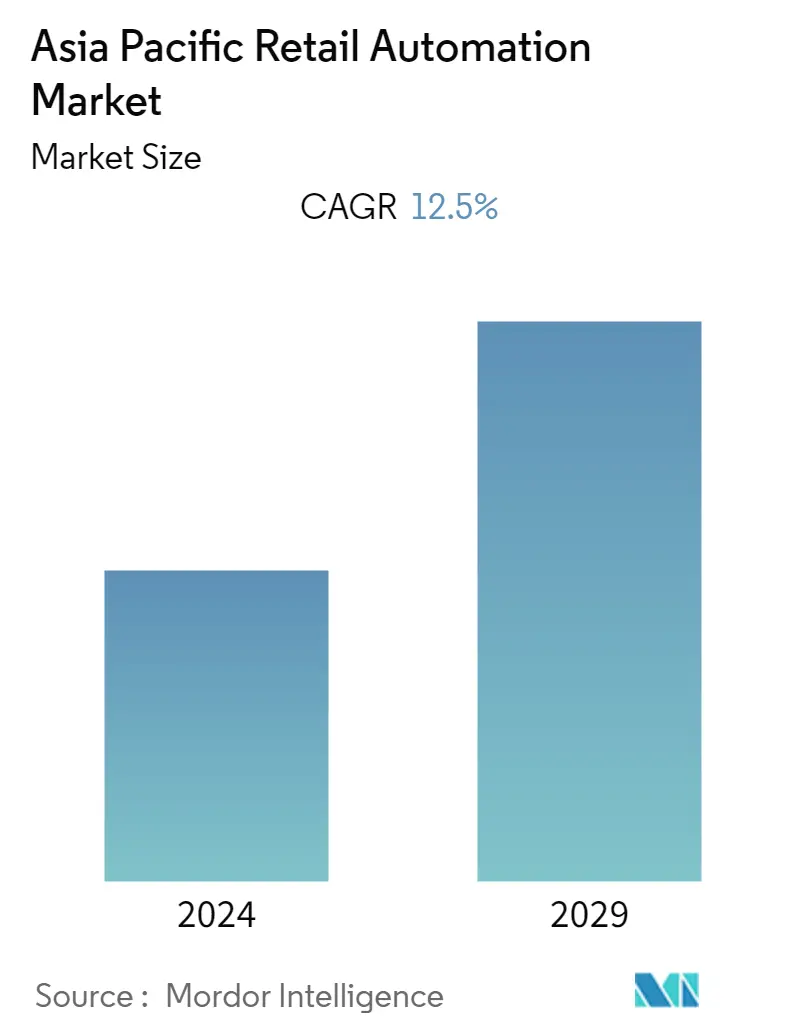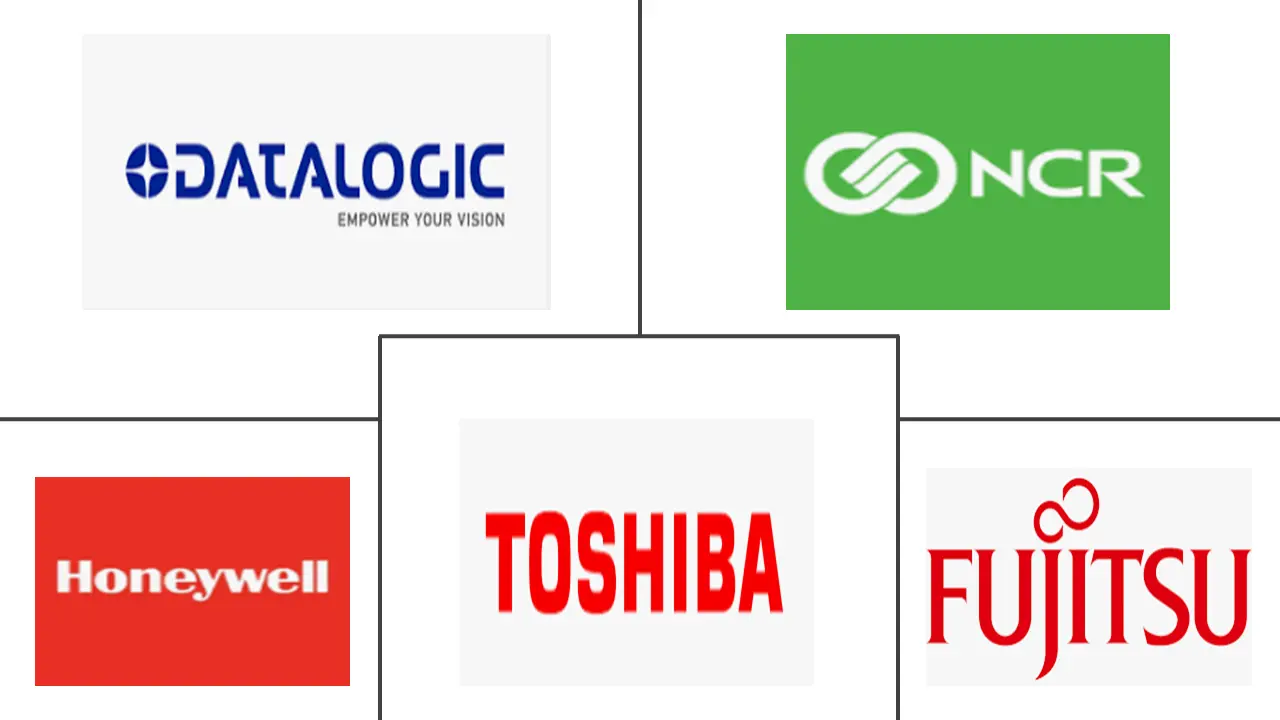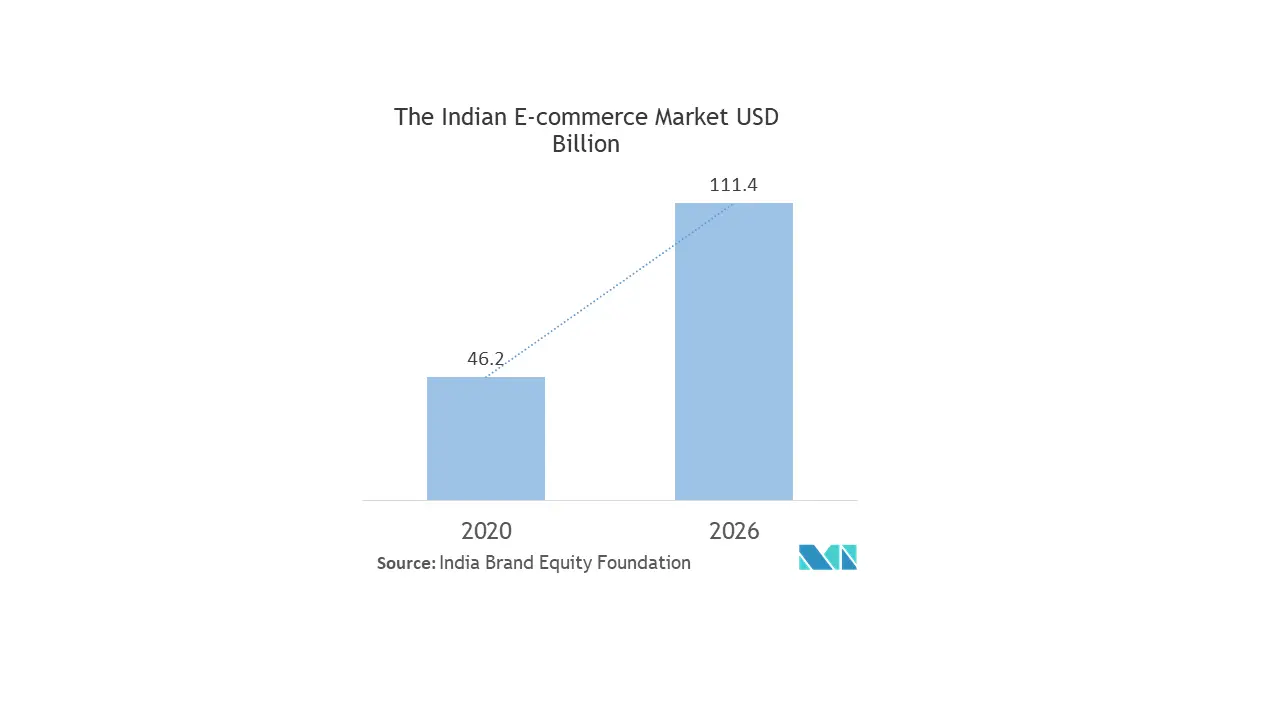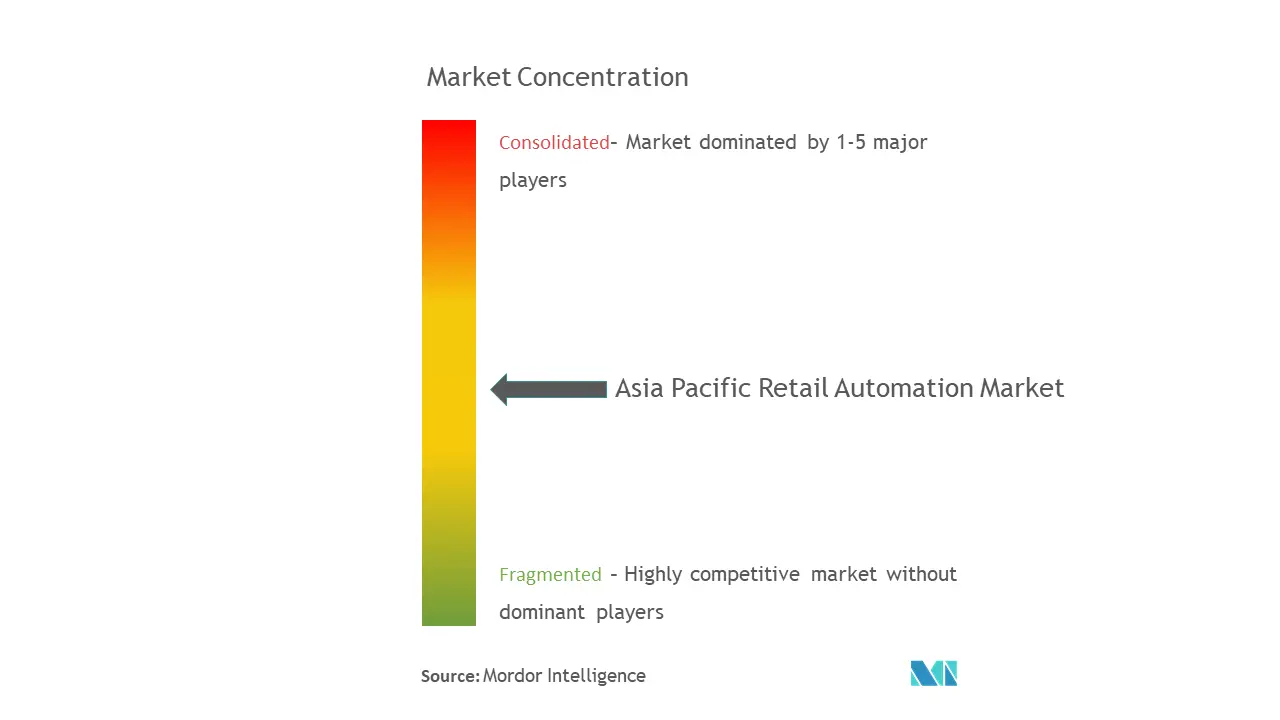APAC Retail Automation Market Size

| Study Period | 2019 - 2029 |
| Base Year For Estimation | 2023 |
| Forecast Data Period | 2024 - 2029 |
| Historical Data Period | 2019 - 2022 |
| CAGR | 12.50 % |
| Market Concentration | Medium |
Major Players
*Disclaimer: Major Players sorted in no particular order |
Need a report that reflects how COVID-19 has impacted this market and its growth?
APAC Retail Automation Market Analysis
Asia Pacific Retail Automation Market is expected to grow at a CAGR of 12.5% during the forecast period 2020-2026. One of the primary factors driving the growth of the retail automation market is the increase in demand for advanced automated systems in retail across the Asia Pacific. Because of the several benefits it provides, such as precision, low cost, high-quality performance, and speed, it has accelerated market expansion. Accounting and bookkeeping, inventory management, purchasing, analytics reporting, and other repetitive operations are automated with advanced systems.
- In developing countries across the Asia Pacific, the number of physical stores is gradually expanding. The majority of people choose to buy daily-basis items from stores since they are convenient. As a result, despite the expansion of e-commerce, some visitors still prefer to shop in physical stores. The retail industry's increasing technologies will have an impact on bringing more people into physical locations. The advantages of automated technologies have prompted businesses to incorporate them into physical storefronts. As a result, the retail automation market for in-stores is expected to develop in the future years.
- Automation has become more common in the retail sector as a result of technological improvements. The advantages of automated retail have raised awareness of the benefits of automation in retail operations, such as purchase/sales services, inventory optimization, inventory optimization, and others, all of which are projected to fuel market growth. For instance, automated guided vehicles are used in warehouses to conduct heavy-lifting duties because they can operate continuously and complete repetitive tasks with the same efficiency and accuracy. As a result, the rise of autonomous guided vehicles (AGV) and other technologies in the retail business has encouraged automation adoption in the Asia Pacific.
- The food and non-food segment are considered an essential industry vertical in the retail automation market. This is due to tremendous improvement in the food and beverage business, increasing the number of restaurants, cafeterias, and franchisees. Non-food services, on the other hand, are progressing as many retail suppliers seek solutions for logistics, in-store support, product inspections, and promotional planning, which is positively impacting the retail automation market.
- COVID-19 pushed retailers to invest in automation technology (such as automated inventory management, robotic picking, analytics reporting, and so on) to improve operational efficiency and lower labor expenses. For instance, when compared to manually picking things off store shelves, the application of deep learning and robots provides significant time and cost savings. Now that the COVID-19 pandemic has sparked a surge in demand for online shopping, supermarket stores want to protect their employees while meeting customers' continuous desire for quick delivery.
APAC Retail Automation Market Trends
This section covers the major market trends shaping the APAC Retail Automation Market according to our research experts:
Significant Upsurge in E-commerce Sector
- The rise of e-commerce and the need for quick distribution of goods to obtain a competitive advantage has resulted in a tremendous demand for retail automation products such as Barcode Reader, Card Reader, Kiosks, Self-Checkout Systems, etc. As a result, prominent retail automation providers have a significant chance to develop digital solutions to improve old operations.
- For instance, Datalogic S.p.A. has decided to invest in "AWM Smart Shelf," a computer vision and artificial intelligence firm situated in California. This initiative intends to keep up with developing trends in cashierless/autonomous checkout, consumer demographics and behavior tracking, automated inventory intelligence, and a Retail Analytics Engine (RAE) for in-store analytics and reporting. The focus is more especially on Frictionless Shopping along with Automated Inventory Solutions, two increasingly crucial areas for improving customer convenience on the one hand and store efficiency on the other.
- Moreover, as an alternative to in-house fulfillment, many retail businesses have turned to third-party logistics providers (3PLs) to meet their online needs. As real-time tracking and tracing become the new standard, retail automation products are projected to expand in popularity in the logistics business.

Increasing Demand for Handheld Barcode Readers
- Increasing demand for handheld barcode readers/ scanners across various industry verticals includes transportation and logistics, warehouse, healthcare, hospitality, oil and gas, etc., is one of the key trends in the retail automation market in the Asia Pacific. For instance, Inventory management and asset tracking are made easier using handheld barcode readers/scanners. Handheld barcode readers/scanners are often small and lightweight, making them ideal for covering large areas at end-users like warehouses.
- Moreover, handheld barcode readers are less expensive than fixed barcode readers/ scanners. Various retailing companies like Wal-Mart Stores, Tesco, Carrefour, and Metro have embraced handheld barcode readers/ scanners. Handheld barcode readers/scanners are versatile, reading and scanning both one-dimensional and two-dimensional barcodes. Businesses can save money on upkeep because of the device. Due to the device's low cost, even small companies may readily adopt and upgrade to a current asset and inventory management system.
- Handheld barcode readers/scanners can now be readily connected to iOS or Android-based mobile devices such as tablets, smartphones, and laptops. This makes data handling easier for the device by allowing it to scan and store real-time data.
.webp)
APAC Retail Automation Industry Overview
Asia Pacific Retail Automation Market is partially fragmented. Some of the major players in the market are Fujitsu Ltd., Toshiba Corporation, Seiko Epson Corporation, Honeywell International Inc., NCR Corporation, Datalogic S.P.A. Recent Developments made in this sector are:
- In July 2021, Epson introduced the "OmniLink TM-T88VII" fastest POS receipt printer, which offers lightning-fast print speeds and flexible connectivity between multiple devices to help merchants - especially in high-volume industries like retail, hospitality, and grocery - deliver the best customer experience in virtually any environment.
- In August 2020, Toshiba Corporation released "ScanSure," a new barcode solution for manufacturers in various industries that allows them to assess the readability and accuracy of printed barcodes. The new product, ScanSure, was created expressly to answer client demands for a dependable label validation solution that is also simple and intuitive to use.
APAC Retail Automation Market Leaders
Datalogic S.P.A
Fujitsu Limited
Toshiba Corporation
NCR Corporation
Honeywell International Inc.
*Disclaimer: Major Players sorted in no particular order

APAC Retail Automation Market News
- December 2020, Fujitsu Limited partnered with Zippin as a distributor of the company's checkout-free solution across Japan. The agreement enables Fujitsu to develop a retail solution to provide a novel customer experience, leveraging Zippin's checkout-free SaaS platform with cashless operations to enhance bandwidth and save staff time, which the businesses see as being especially important during the epidemic.
- January 2020, Honeywell International Inc. worked with KOAMTAC Inc. to improve the performance of its barcode scanner by incorporating a barcode decoder via the SwiftDecoderTM app. SwiftDecoder using a Tablet or Smartphone's camera is slightly slower and less handy than a dedicated barcode scanner, but it is also less expensive.
APAC Retail Automation Market Report - Table of Contents
1. INTRODUCTION
1.1 Study Assumptions and Market Definition
1.2 Scope of the Study
2. RESEARCH METHODOLOGY
3. EXECUTIVE SUMMARY
4. MARKET INSIGHTS
4.1 Market Overview
4.2 Value Chain / Supply Chain Analysis
4.3 Industry Attractiveness - Porter's Five Force Analysis
4.3.1 Threat of New Entrants
4.3.2 Bargaining Power of Buyers
4.3.3 Bargaining Power of Suppliers
4.3.4 Threat of Substitute Products
4.3.5 Intensity of Competitive Rivalry
4.4 Assessment of COVID-19 impact on the Industry
5. MARKET DYNAMICS
5.1 Market Drivers
5.1.1 Increasing retail stores
5.1.2 Increase in the adoption of digitization across retail sector
5.2 Market Restraints
5.2.1 At unattended terminals, there is a risk of theft
6. MARKET SEGMENTATION
6.1 Product Type
6.1.1 Point-of-Sale Systems Requiring Manual Intervention
6.1.2 Unattended Terminals
6.2 Product
6.2.1 Barcode reader
6.2.2 Weighing scale
6.2.3 Currency Counter
6.2.4 Bill Printer
6.2.5 Cash Register
6.2.6 Card Reader
6.2.7 Kiosks
6.2.8 Self-Checkout Systems
6.2.9 Others
6.3 End-user Application
6.3.1 Food/Non-Food
6.3.2 Oil and Gas
6.3.3 Transportation and Logistics
6.3.4 Health and Personal Care
6.3.5 Hospitality
6.3.6 Others
6.4 Country
6.4.1 China
6.4.2 India
6.4.3 Japan
6.4.4 South Korea
6.4.5 Rest of Asia Pacific
7. COMPETITIVE LANDSCAPE
7.1 Company Profiles
7.1.1 Datalogic S.p.A.
7.1.2 Diebold Nixdorf
7.1.3 Fiserv, Inc.
7.1.4 Fujitsu Limited
7.1.5 Honeywell International Inc.
7.1.6 KUKA AG
7.1.7 NCR Corporation
7.1.8 Seiko Epson Corporation
7.1.9 Toshiba Global Commerce Solutions
7.1.10 Zebra Technologies
- *List Not Exhaustive
8. INVESTMENT ANALYSIS
9. FUTURE OF THE MARKET
APAC Retail Automation Industry Segmentation
The term "retail automation" refers to the use of computers and technology to create processes, systems, and workflows that operate independently and with little or no human intervention. Barcode readers, weighing scales, currency counters, bill printers, cash registers, card readers, kiosks, self-checkout systems, and other automation technology are part of an automated retail system. Automation has plowed its way into areas such as food/non-food, oil & gas, transportation & logistics, health & personal care, and hospitality due to the retail sector's adoption of technology.
| Product Type | |
| Point-of-Sale Systems Requiring Manual Intervention | |
| Unattended Terminals |
| Product | |
| Barcode reader | |
| Weighing scale | |
| Currency Counter | |
| Bill Printer | |
| Cash Register | |
| Card Reader | |
| Kiosks | |
| Self-Checkout Systems | |
| Others |
| End-user Application | |
| Food/Non-Food | |
| Oil and Gas | |
| Transportation and Logistics | |
| Health and Personal Care | |
| Hospitality | |
| Others |
| Country | |
| China | |
| India | |
| Japan | |
| South Korea | |
| Rest of Asia Pacific |
APAC Retail Automation Market Research FAQs
What is the current Asia Pacific Retail Automation Market size?
The Asia Pacific Retail Automation Market is projected to register a CAGR of 12.5% during the forecast period (2024-2029)
Who are the key players in Asia Pacific Retail Automation Market?
Datalogic S.P.A, Fujitsu Limited, Toshiba Corporation, NCR Corporation and Honeywell International Inc. are the major companies operating in the Asia Pacific Retail Automation Market.
What years does this Asia Pacific Retail Automation Market cover?
The report covers the Asia Pacific Retail Automation Market historical market size for years: 2019, 2020, 2021, 2022 and 2023. The report also forecasts the Asia Pacific Retail Automation Market size for years: 2024, 2025, 2026, 2027, 2028 and 2029.
Asia Pacific Retail Automation Industry Report
Statistics for the 2024 Asia Pacific Retail Automation market share, size and revenue growth rate, created by Mordor Intelligence™ Industry Reports. Asia Pacific Retail Automation analysis includes a market forecast outlook to 2029 and historical overview. Get a sample of this industry analysis as a free report PDF download.
